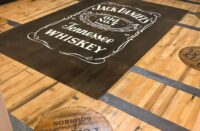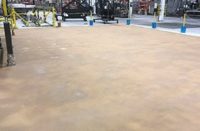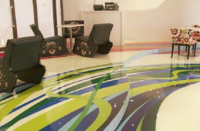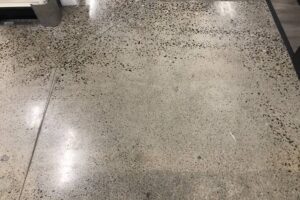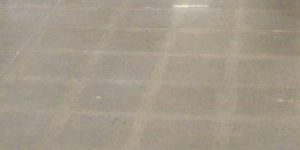
Question: In our case, we have integrally colored concrete. My contractor placed blue painter’s tape on the concrete for a few days to mark the placement of cabinetry. The tape was removed and the concrete was sealed with two coats of 25 percent solids acrylic sealer and two coats of acrylic finish. A few days later the concrete was discolored and had evidence of where the tape had been placed. No surface damage to the concrete was evident.
Why did this happen and how can it be fixed?
Defining the issue
This issue is called ghosting or shadowing. The good news is that over the past decade the number of questions and complaints like this has greatly declined. I attribute that to experience, more people talking about the predicament and the internet.
I can remember researching the topic for a presentation on troubleshooting about 10 years ago, and there was nothing out there. It seemed I was breaking new ground on the subject. Today, a quick search brings up lots of articles and blog posts from professionals and DIYers alike.
Ghosting or shadowing occurs when contamination, residue or discoloration from a previous covering appears on your decorative finish. It usually shows up as a translucent mark in the same shape as the previous source and, in many cases, ruins what would otherwise be a beautiful floor.
Getting to the source
The major sources of ghosting and shadowing are:
- Tile. Probably the most common culprits are ceramic and stone tile. The difference in moisture transfer between the tile and grout create a permanent difference in the concrete. The difference from the grout lines transfers through thin overlays and shows up in translucent stains and coatings.
- Vinyl composition tile. VCT is another common source. The same mechanism as tile causes the issue with VCT, only the lines are usually thinner because the tiles or sheets touch each other.
- Wood. Shadowing or ghosting can occur not only from wood flooring, but also when plywood or lumber is left on newly placed concrete. During curing, a differential in moisture under the wood compared to exposed concrete causes these marks.
- Cans and pails. Typical construction containers left to sit on the concrete during curing create distinct shadow rings.
- Contamination. Soda, coffee and tobacco are all acidic. These mild acids can micro-etch the concrete. The etch is often light enough that you don’t see it when the concrete is dry and/or unsealed, but once a stain or sealer is applied the ghost mark in the shape of a spill or spit is noticeable.
- Previous construction. A back-filled trench or core from a repair in the concrete can often shadow through, even if 2 inches of concrete are placed over the repair.
- Tape. This one is probably the least known, but most deadly. The glue from tape migrates into concrete and when the tape is removed the glue residue remains. This area resists stain and sealer and makes for long unsightly shadow lines.
- Internal elements. When it comes to full-depth concrete, anything in the concrete needs to be placed deep enough to avoid shadowing. Rebar and radiant heat tubes can cause shadowing if they’re placed too close to the concrete surface.

Dealing with the problem
The best way to deal with the issue is to avoid it. If you’re in the business of staining, sealing, coating, polishing or overlaying, you need to consider every floor a potential candidate. This is especially true when you’re working on a floor that had some previous floor covering removed.
Other obvious ways to avoid the issue are to make sure nothing sits on the floor during the initial 30-day curing period, and never tape directly to the concrete before or after sealing.
If an overlay or opaque coating is going to be applied to a floor with the potential for ghosting or shadowing, a high-solids primer or crack-suppression system is a must. These resin- and cement-based primer systems act as physical barriers and prevent shadowing from appearing on the surface.
In the case where tape was applied or some other resin-based contamination is present, a solvent or chemical cleaner can be used to remove the residue.
When the concrete is damaged or the potential shadowing is not moisture related, a thin overlay can be used. It will cover the issue and provide a new surface on which to work. This is not a good candidate for moisture-related shadowing because the overlay is not thick enough to block the shadow from transferring through.
The real bummer with ghosting and shadowing is that there isn’t a lot that can be done once it shows up. In many cases, it’s a pattern covering the entire floor, so spot treatment is not feasible. Even with small areas like tape marks, finding a coating or stain to cover the issues while still having it blend in with the new decorative finish is difficult.

An easy way to test for shadowing issues is to spray the surface with water prior to applying the sealer. In many cases, the water will darken surface areas where potential ghosting or shadowing may occur.
Back to the original question
Getting back to the issue with the tape on the integrally colored floor, the options for repair are limited. A tinted finish can be applied to try to hide the tape marks. Another option requires stripping all the sealer, using a solvent to remove the glue residue, then using a stain or dye to touch up the color before resealing.
In my experience, none of these options produces a seamless repair, and some part of the ugly ghost or shadow remains visible. The success of these types of repairs usually comes down to how artistic you can be in covering the spots, and how understanding the client is.
I’ve seen ghosting and shadowing on concrete 2 inches thick, on thin overlays, through stains and dyes, on integrally colored and gray concrete, as well as on sealed and polished concrete. Overall, it can occur on any surface.
As with most decorative finishes, aesthetics and color are a major part of the finish, so ghosting and shadowing are especially detrimental in a decorative concrete project. Shadowing and ghosting are issues that don’t occur very often, but when they do they can be permanent and very difficult to hide. A little extra time on the front end in regards to testing the surface and using a primer or topping can go a long way to avoiding costly repairs if shadowing and ghosting do occur.
